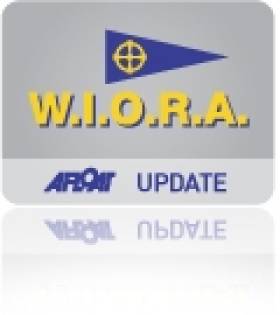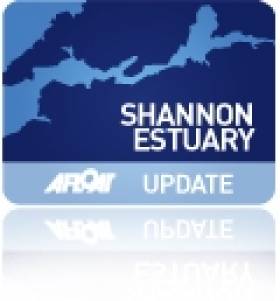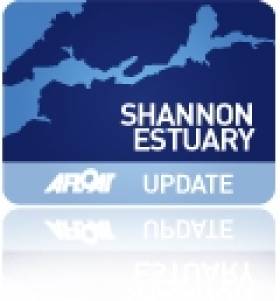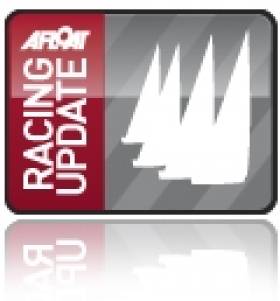Displaying items by tag: WIORA
Mayo Sailing Club Hosts WIORA West Coast Championships
#WIORA - The West of Ireland Offshore Racing Association’s (WIORA) West Coast Championships will be held on Clew Bay from Wednesday 23 to Saturday 26 July 2014.
As reported last October on Afloat.ie, Mayo Sailing Club in Rosmoney will play host to the fleet of up to 30 boats from around the country that will vie for the coveted titled of 'Champion of the West'.
The main attraction will be preceded by a week of events starting with the O’Sullivan's Marine 100 Mile Race the weekend before the West Coast Championships, on a course set from the Aran Islands in Galway Bay to Mayo Sailing Club.
Meanwhile, charter boats are available all around Clew Bay to get the best views of the action while doing some fishing, having a picnic on board or just enjoying being out on the water and taking in the sights.
You can also meet the skippers and crew at the daily after-race party at Mayo Sailing Club, where there will be food, teas and coffees, entertainment and an open bar.
Live music will be provided by the Hip Pocket Trio and their jazz soul stylings on Wednesday 23, singer-songwriter Dennis McCalmont on Thursday 24 and pop-rocking three-piece Old Tricks on Friday 25 July.
Mayo Sailing Club to Run WIORA West Coast Championships in July
WIORA's 'West Coast Championships' will take place from Wednesday, 23rd July to Saturday, 26th 2014, and will be hosted by Mayo Sailing Club at Rosmoney, on Clew Bay. A fleet of up to 30 boats will take advantage of the new pontoon facilities near the club house.
Rosmoney near Westport is the base for the Sailing Club whose members enjoy the excellent sailing grounds that exists among the archipelago of islands in the east of Clew Bay.
The important new pontoon facility is located approximately 30 metres from the edge of the permanent pier and has been in constant use by Mayo Sailing Club, islanders, boatmen since it opened in April 2013.
Foynes Yacht Joyrider Wins Overall Prize at WIORA 2012
#WIORA – The West of Ireland Offshore Championship's, which were hosted by Foynes Yacht Club last week on the Shannon Estuary was a great success for the for the club writes Gerry Ryan.
The last time the championships were hosted by the club 14 years ago, which is a long time to wait for such a prestigious championship. A total of 28 yacht's raced in four different divisions: Class 1, 2 and 3 and in the ever popular and growing White Sails Division.
The championships are one of the top events on the west coast sailing calendar and vessels from as far away as Sligo to Fenit travelled to compete in the golden jubilee of FYC.
The weather during the week was mixed with the wind strengthening to force 4 on some of the days with a very wet day on the Thursday.
A total of one race was scheduled for Wednesday, where two were raced on Thursday, Friday and Saturday.
Officer of the Day, Liam Dineen set challenging courses for the event, and mostly all the courses were set in Olympic Triangular fashion, where racing took place west of Foynes Island concentrating between the Clare shore at Labasheeba and Mount Trenchard on the Limerick side.
Vantage points were taken up on the coast road leading to Tarbert and Ballybunion, where the public could view the superb racing that was on offer.
In his opening speech at the presentation of prizes FYC Commodore Tom Murray said that he was delighted so many boats from the club's on the west coast and especially from Iniscealtra from Lough Derg took part in the event. He thanked the committee, member's of the club and an Slua Muiri in giving assistance to the event.
Foynes Yacht Club took several of the top prizes with Andrew Bracken sailing in Class 1 IRC on Joyrider received the Clifford Cup overall trophy and the winning class trophy the Ita McGibney Cup. His crew consisted of David Taylor, who won the IRC National Championship's in Scotland, he also had Stephen Ferris, Steve Atkinson, Killian Glynn, Evan Tobin, who is a National Topper Champion, Annemarie Glynn, Dominic O'Sullivan and Eddie Bracken.
In Class 1 Echo, another Foynes boat, Dexterity received the laurels in taking the overall prize. Team Foynes were delighted with this win, and after the presentation a member of the winning crew described the win as 'fantastic'. The crew were Alan McEneff, Liam Madden, Ger Hobbs, Kevin Hoare, Rory Buckley and Jane Maher.
Ray McGibney, skipper of Dis-A-Ray took the honours in Class 2 IRC, which was a great achievement for them, especially because they were up against a strong fleet of participating boats.
A name synonymous with Foynes Yacht Club 'McCormack' did not let the side down, James McCormack, skipper of Alpara won the White Sails Division with his crew of Darragh, Cian, Jamie, Mary, Patricia McCormack, Anna Lowes, Chris McDaid and Mary Glynn.
Brian O'Sullivan on Reconnaissance from Tralee Bay Sailing Club won IRC and ECHO in Class 3, and Serendipitiy of Solent skippered by Robert Bourke from Inishcealtra Sailing Club won White Sails Division 1.
Overall results: Class 1 IRC, Joyrider. Class 1 Echo, Dexterity. Class 2 IRC and Echo, Dis-A-Ray. Class 3 IRC and Echo, Reconnaisance. White Sails Division 1: Serendipity of Solent. White Sails Division 2: Alpara. Overall winners in IRC: Joyrider, Andy Bracken. Overall winners in White Sails Division: Alpara, James McCormack.
Joyriders Out in Front at WIORA on the Shannon Estuary
#WIORA – In an ebb tide the West of Ireland Offshore Racing Championship's hosted by Foynes Yacht Club got off to a terrific start yesterday on the Shannon Estuary. Race Officer, Liam Dineen set a challenging course for some of the classes. Competitors who travelled from Sligo to Mountshanon, enjoyed fine sailing in a steady north-westerly winds of 30 knots that kept the four fleets entertained for the passage race, which was raced east of Foynes Island to the Loughill navigation buoy.
Results:
Class 1 IRC: 1st Joyrider, 2nd Mustang Sally, 3rd Dexterity.
Echo: 1st Mustang Sally, 2nd Joyrider. 3rd Dexterity.
Class 2 IRC: 1st Dis-A-Ray. 2nd 2602. 3rd Golden Kopper.
Echo: Dis-A-Ray. 2nd 2602. 3rd Golden Kopper.
Class 3 IRC: 1st Reconnaissance. 2nd Jaws. 3rd Battle.
Echo: 1st Reconnaissance. 2nd Jaws. 3rd Battle.
Whiite Sails Division One: 1st Serendipity of Solent. 2nd Wyte Dolphin. 3rd Kerry Dream.
White Sails Division Two: 1st Alpara. 2nd Jabiru. 3rd Sea Saw.
#wiora – Over 30 yachts are coming from clubs in Sligo, Mayo, Westport; Galway, Clifden; Kerry, Fenit; Kilrush, Lough Derg, Inniscealtra and Dromineer, Mountshannon, and from the east coast, Howth Yacht Club to race on the scenic Shannon Estuary in next weeks WIORA championship.
Foynes Yacht Club, based on the shores of the Shannon Estuary in Cooleen Point will be hosting the five day event, an important honour for the club in a year that it celebrates the golden jubilee anniversary of it's founding in July 1962.
The championships will take place from Wednesday, July 11 to Saturday, July 14 inclusive.
Racing will be run in three different classes: Class 1, 2 and 3 in the IRC and Echo handicap system, and the ever popular White Sails division will compete under the Echo handicap system only.
The last time that the club hosted the championship's was in 1998.
Practice races may take place on the Monday and Tuesday prior to the championship's to get the different class yacht's fine tuned.
Quality catering is assured, and top class entertainment will be provided in the Clubhouse during the week.
This, of course being a special year for Foynes Yacht Club, which culminates in quite a lot of preparation and organisation in hosting this prestigious championship on the west coast of Ireland.
Principal race officer, Liam Dineen is looking forward coming to Foynes once again to take the helm. Incidentally, Liam was race officer for the highly successful national Mermaid championship's, which the club hosted in the summer of 2010.
All yacht's that enter the championship's will be given a free berth or mooring for the duration of the event, and yacht lifting and mast stepping facilities will also be provided.
#foynes – On Sunday next Foynes Yacht Club willl be hosting the annual Carrigaholt race, where all classes will participate in racing writes Gerry Ryan. Classes 1, 2, White Sails and the Mermaid fleet will be competeing for the Carrigaholt trophy. It is anticipated that racing will start at 10am from the club line.
It is nearly time now for the West of Ireland Championship's that the club is hosting in early July. Preparation is going according to plan and an entry of 40 yachts have signed up for the event. Of course, as member's are aware this is one of the biggest sailing events in the West coast calendar this year.
Last Saturday the second leg of the Estuary Bell, where the Officer of the Day, Conor Roche chose east of Foynes Island for racing. The conditions for racing was a west-northwest wind force 5.
Leading from the first leg, which took place place on Saturday, June 9 and Sunday, June 10 in Kilrush Dis-A-Ray in Class 1 in IRC.
Class 1 were sent off on longer beats and had to deal with very testing conditions with flying spinnakers. In race 1 Dexterity ran into difficulty on the last leg and had an alarming Chinese gybe in front of the committee boat just short of the the finish line, which cost them line honours. Unfortunately, they had to retire because of this.
Dis-A-Ray and Hero battled it out for both races and only seconds separated them at the finish. In race 1 Dis-A-Ray took the laurels more than half a minute ahead of Hero, while in race two Hero finished ahead of Dis-A-Ray on corrected time.
However, on corrected time, Hero, with the much higher handicap were placed behind Dis-A-Ray each time. John Conway on Golden Kopper put in a great performance to take a place in race 2 on corrected time.
In the White Sails division courses set had more reaching than beating, which were fine judging from the weather conditions.
Skippers made the decision to reef the mains and sail with a smaller headsail. The wind abated from 30 knots to 25 for race 2.
In race 1 Pat Finucane on Marengo and Brian O'Donnell on Whyte Dolphin were neck and neck for most of the race, O'Donnell on Whyte Dolphin pulled away on the final leg to decorate the mahogany.
Results: Race 1 IRC, 1st Ray, (Ray McGibney); 2nd Hero (Adrian O'Connell); 3rd Golden Kopper (John Conway), and 4th Dexterity (Foynes Team).
Race 2 IRC: 1st Dis-A-Ray. 2nd Golden Kopper. 3rd Hero.
White Sails: 1st Whyte Dolphin (Brian O'Donnell); 2nd Marengo (Patrick Finucane), 3rd Battle (Elaine O'Mahoney.
Race 2: Battle was first across the line but were beaten on corrected time. 1st Whyte Dolphin. 2nd Battle. 3rd Marengo.
Thanks to Ger Reidy on the use of his vessel for the committee boat.
Over Forty Yachts Sign up for WIORA week on the Shannon
46 craft have put pen to paper for WIORA, and it is envisaged that 50 craft will be taking to the water's of the Shannon Estuary for Foyne Yacht Club's golden jubilee and it hosting of the West of Ireland Offshore Racing (WIORA) Championship's from Wednesday, July 11 to Saturday, July 14 writes Gerry Ryan.
Three classes will be organised for the event IRC, Echo and White Sails. Liam Dineen has been appointed Officer-of-the-Day for the championships.
This coming Saturday, April 14 'lift-in' is scheduled to take place for all craft at Foynes Yacht Club Officially, this will be the start of the much anticipated sailing season in Cooleen Point. While the standard around the 'can's' windward-leeward course's will be laid for the IRC and Echo fleets, more varied courses for the White Sails division will be set, taking the fleet to all parts of the Estuary.
Peader McGrath, who is rib manager for WIORA week has asked for rib drivers and assistants for this week. Any member's who would have time to assist are asked to contact Peader on 087 2600817.
To kick-off the season a cruise for all craft on the estuary is organised for Saturday, April 21, this will take place in the afternoon where a Bar-B-Que will take at the clubhouse after the cruise.
Brendan Buckley and Ciara McCormack on qualifying as dinghy instructions, one of their first briefs is to develop a plan for the junior racing during the season. These two individuals have a wealth of experience in the rudiments of sailing. It augurs for the junior member's of the club, where the sailing school is going from strength to strength.
The sailing school will officially start proceedings on Monday, June 11 until the end of July (it will not operate WIORA week).
The new club polo shirts, hoodies and jackets with the new 50th anniversary logo are available in the club. These are available in an assortment of colours and sizes.
Foynes YC to Host 2012 WIORA West Coast Championships
#WIORA– As a flagship event to mark their 50th year of sailing on the Shannon Estuary, Foynes Yacht Club are setting an aggressive target to attract 50 boats to next year’s West of Ireland Offshore Racing Association (WIORA) sailing championships to be held from the 11th to 14th of July. The WIORA poster is below.
Ed Conway and Raymond McGibney are flying the flag for Foynes having being recently re-elected to the WIORA committee for another year.
IRC, ECHO and White Sails classes will be raced and the club says a festival atmosphere ashore will be 'guaranteed with well-priced, quality catering and top class live entertainment' provided at the recently renovated clubhouse.
All boats entered will be given free and secure berthing. Free lift-in/lift-out of trailer sailors will also be arranged. Liam Dineen has been appointed OOD and already over forty boats have registered.
In addition to all Western clubs, Foynes will be canvassing sailors from the active racing fleet on Lough Derg to come by road or river to join in this celebration sailing event, last held in Foynes in 1998.
While standard “around the cans” windward-leeward courses will be laid for the IRC and Echo fleets, more varied courses for white sails will be set, taking yachts to all parts of the scenic estuary. A special section is currently being added to the club website to cover all aspects of the event.
More on The Estuary here

Racing Round up: Dragons, British IRCs, Flying Fifteens, WIORA, ISA Youths, Fastnet and Bay racers
The overall winner of the 2011 West Coast Championships (WIORA) is Glen Cahill's "Joie de Vie" of Galway. Cahill won the IRC 1 division. Local boats filled the class two and three slots on IRC. David Griffin's "Egalite" of Clifden was the Class 2 IRC winner and club mate. Jackie Ward sailing "Hallmark" of Clifden was the Winner of Class 3 IRC. Winners as announce by Clifden BC are:
Class 1 IRC Glen Cahill's "Joie de Vie" of Galway.
Class 1 ECHO Glen Cahill's "Joie de Vie" of Galway.
Class 2 IRC: David Griffin's "Egalite" of Clifden.
Class 2 ECHO: Team "Ibaraki" of Galway.
Class 3 IRC: Jackie Ward's "Hallmark" of Clifden
Class 3 ECHO: Donal McCormack's "Battle" of Foynes.


































































